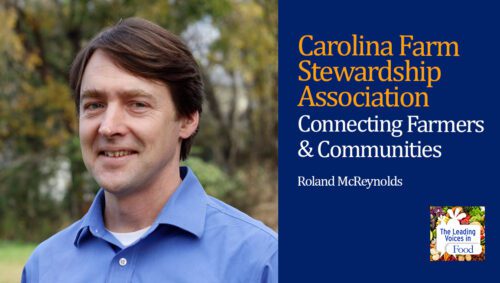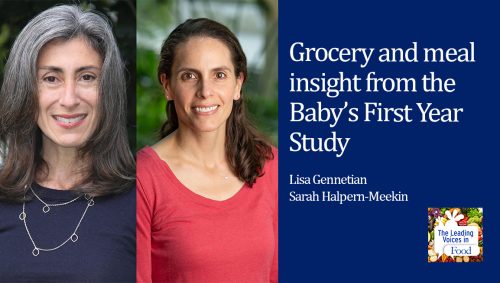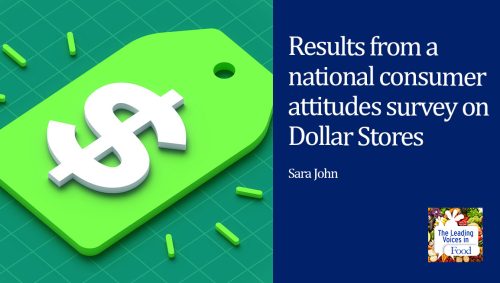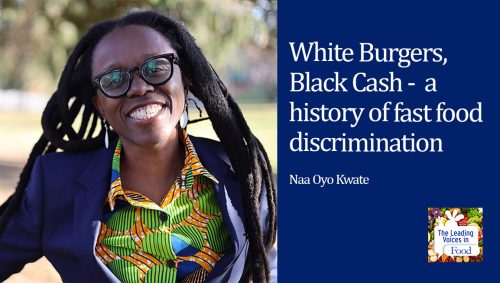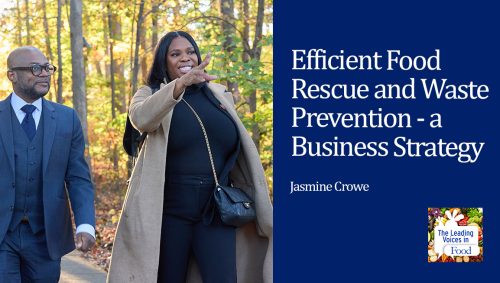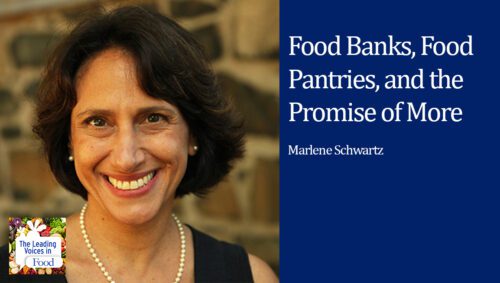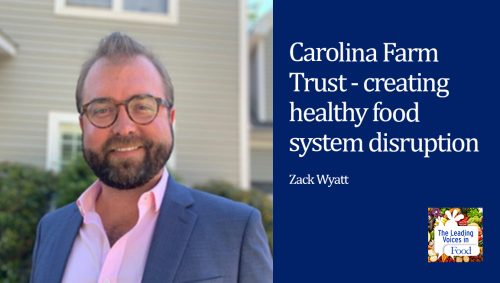The Leading Voices in Food
E186: Deep dive into challenges people face accessing food pantries
The COVID-19 pandemic deeply impacted the US food chain and has heightened attention on nonprofit food pantries and soup kitchens. Today’s guest argues that sometimes the people most in need of food face the most challenges in getting it because of food pantry operating procedures. Our guest, Alana Stein has conducted research on these issues at the University of California at Davis.

Alana Haynes Stein is a Ph.D. Candidate in the Department of Sociology at the University of California, Davis. Her research uses theories of political economy, stratification, and organizations to study inequalities in the food system. In her research, she pulls on the methods of ethnography, in-depth interviews, geospatial analysis, content analysis, and network analysis. Alana’s dissertation focuses on the resources, practices, and decision-making of U.S. food banks during the COVID-19 pandemic. The research focuses on understanding how the privatization of food assistance and food bank networks impact access to resources. Her mixed methods dissertation employs geospatial analysis to examine food bank resources in relationship to demographic characteristics, and she uses in-depth interviews with food bank leaders coupled with archival research to compare the programs and practices of different types of food banks.
Interview Summary
I’m really happy you could talk to us about these important issues because these food banks and food pantries and other enterprises like this are really important at any time but especially when there’s a crisis on the food system like the pandemic created. So let’s dig into the work that you’ve done on the barriers to assistance. Now you published a paper recently in the journal “Social Currents” about this. So could you explain to our listeners how you went about doing your research?
The research for this project actually took place before the pandemic and started as a public scholarship project at the request of the food bank. They wanted to know more about the barriers people experience trying to access their services and particularly for people experiencing homelessness. I did over 200 hours of participant observation at the programs of the food bank working as a volunteer, focusing my observations on two produce-focused distributions that the food bank operated. I also did 21 in-depth interviews with food assistance clients, focusing primarily on interviewing people experiencing homelessness.
It’s interesting to think about these qualitative methods of interviewing people and what can be learned from them. So given that you did these in-depth intensive interviews, what are some of the barriers that you found in accessing these food assistance programs?
So the food amounts really varied from week to week. The clients who came through the distribution first had a lot more choice about which foods they could take. This meant people started waiting in line the night before to try to get the earliest spots in line. Sometimes clients would be offered 10 loaves of bread. Other weeks, clients wouldn’t be offered any bread at all. So clients really faced a lot of variability and not knowing what types of food they would get or what sorts of food would be available and the amounts that would be available. Not everyone could even eat the bread to begin with, such as if people had gluten intolerance, and some people also had diabetes, which was really forcing them to watch how many carbs they were taking in.
Some of the people also faced barriers with their lack of kitchens. A lot of times, these produce-focused distributions would hand out items like large squashes that were supposed to be a lot of the food that people were receiving. But people experiencing homelessness who didn’t have a kitchen weren’t able to use the squash. They weren’t able to prepare it. It needs to be cooked and needed to be cut. Other issues even when things were more readily available to eat, such as yogurts were sometimes available, is people without kitchens didn’t have spoons or utensils to really help with eating. You could ask volunteers for a spoon. That wasn’t something that was regularly advertised, but you had to know to ask, and also, sometimes, the volunteers still said no.
Particularly in California’s hot summers, it was also difficult for people to store the food, particularly if they didn’t have access to refrigeration, and it was just difficult to get your food from a weekly food distribution without having access to food and times in between. There were also barriers around the scheduling and locations of the distributions. So most programs occurred during standard business hours and were only open for a few hours a month, which made it difficult for clients who worked or had other time constraints to access them. Clients had difficulty getting to distributions that were located all over town and then carrying the food with them, especially if they did not have a car. Clients also had trouble accessing information to learn about food distributions and changes to them, and the places that did have information on distributions, like the social services office and food bank website, often were outdated. Some of the distributions also had a heavy security or police presence. So one of the locations for the food distribution I observed was directly across the street from the police office, and you actually had to go under a sign that said probation in order to access the food assistance. People from groups that have historically been targeted by the police, such as people of color and people experiencing homelessness, were more affected by this barrier. Some of the distribution sites also weren’t wheelchair accessible. All these barriers were just things that really compounded and impacted people.
In your paper you mentioned that many people face not only a single barrier but many barriers, and you just kind of put this into a coherent picture in just a little bit of time. It’s really very daunting, isn’t it? These issues that people face, and like the issue of the police presence, I hadn’t even thought about that. That sounds very significant then. Sounds like, again, we get back to that issue that I mentioned in the introduction that the people who may most need the help may face the most barriers, and that’s pretty much what you found in your paper, wasn’t it?
There are a lot of barriers involved in accessing each program, but for the people who had the most need, they often needed to access multiple programs in order to meet their food needs since they couldn’t just meet their needs with the available food from one program. So trying to access multiple programs in and of itself added barriers. But then, people with dietary restrictions and who lacked regular access to a kitchen, particularly people experiencing homelessness, couldn’t eat, store, or prepare many of the foods, which made it even more important to arrive early to have the greatest choice and to attend multiple programs. However, when people experiencing homelessness tried to arrive early the night before the distribution, they ran the risk of attracting police attention for being in a place where overnight camping was not allowed. As people faced other hardships in their life, they struggled to be able to access the programs. Another example, one woman who was housed I interviewed struggled to attend the distributions when she had to take her brother to chemotherapy. She took a chance each week on whether or not she would make it in time to get any food because the program didn’t allow them to set aside food for people, even if they attended regularly and had other barriers to coming.
Well, these are agonizing choices people face, aren’t they? So in your paper, you mentioned the concept of operationalized inequity in this system. What do you mean by that?
When I’m thinking about operationalized inequity, I’m thinking about how the programs are structured and how these programs structures were not set up to accommodate different circumstances. If we think about treating everyone equally, we give everyone the same exact treatment. But, if we think about treating people equitably, we’re really meeting people where they’re at and recognizing the hardships that they face, the historical inequalities that they faced. So even though there was some choice, everyone roughly was treated the same at these programs, but that didn’t mean they were treated equitably. And in the cases where volunteers did use discretion and make exceptions for people, they often did not do so in ways that accommodated the clients that were the most in need. They often did so in ways that accommodated the clients that they said were their favorites.
So if nonprofits are in business to serve people in need, why are some of them operating in this way?
So most food banks focus on the amount of food that they distribute as a key metric. This encourages food banks to focus on distributing more pounds of food each year rather than really focusing on how they can better serve populations that face the most hardships. So rather than taking people’s actual circumstances into account, programs were more built on assumption that they could have a one size fits all model. There’s a cultural assumption that often underlies this narrative, and that’s the assumption that if people really need the food, they will find a way to make it work, but that’s a really problematic narrative. It doesn’t account for the many other hardships that people face. People aren’t generally one-dimensionally facing food insecurity. They’re also facing many other hardships that go along with poverty, and it takes away people’s dignity and does not recognize the basic human right to food.
There are so many daunting issues that the organizations need to face in this and that individuals face in accessing what these organizations have to offer. So what are some of the ways that come to your mind about how these food pantries might better serve the clients?
While I focused on one food bank, other scholars who work in studying food banks have recognized many of these same barriers to accessing food assistance and organizations across the country. So I really encourage food assistance organizations to think about how their programs are structured and the barriers that clients may face, particularly the most disadvantaged clients. Another way to potentially recognize more barriers is to include the voices of people with lived experience with food insecurity and other hardships in program design. Food assistance organizations should also think about how they can build flexibility into their programs while also training staff and volunteers about biases and discrimination so that this flexibility is applied equitably. One good thing that has come out of the pandemic is that food assistance organizations have realized so many new ways that they can structure their programs rather than just continuing with the ways things have already been done. I’ve been excited to see home delivery programs and programs that provide clients with cash and vouchers, allowing them to have more choice and options. I think the pandemic really showed food assistance organizations that they can change to accommodate clients’ needs and do things in ways that didn’t seem possible before the pandemic.


